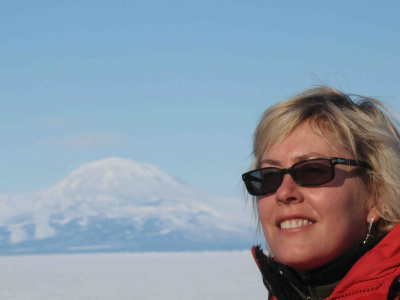☆ SENIOR STAFF
My research activity started in 1994 when I had my master's degree. It concerns Neutrinos, Gamma rays and Cosmic Rays, which in one word we can define as the multi-messengers of the non-thermal universe. Initially in my career, I have been working on atmospheric neutrino oscillations, simulations of neutrino fluxes in the atmosphere with FLUKA, dark matter and neutrino astronomy in the MACRO experiment at Gran Sasso. We found out that the atmospheric neutrinos we detected between millions of muons were oscillating more strongly in the vertical upgoing direction than in the horizon due to the longer baseline in the earth. For this, I was awarded the Duggal Award.
I continued to work on Neutrino Astronomy in the ANTARES undersea telescope since 1999 and in the NEMO.RD experiment of INFN, which then became KM3NeT. In ANTARES, I coordinated for 8 years the working group on astrophysics and exotic phenomena, the main analysis working group of ANTARES. In 2005 I left the continent for an adventure in the USA, which lasted 8 years. I joined the Faculty of the University of Wisconsin as an Assistant Professor and became a tenured Associate in 2007. I worked in IceCube, the first kilometre-cube neutrino telescope ever achieved, located at the South Pole, where I went during a construction season to commission strings and I happened to help deploy some. I mostly concentrated on defining the analysis for searches of time-dependent and independent point and extended sources defining a new method based on likelihood analysis, when the collaboration mostly used binned methods to search around sources. With this method, we found significant indications of signals from the blazar TXS 0506+056 and the starburst galaxy NGC 1068. In 2007 I started work on gamma-ray astronomy and hardware activities in HAWC on the trigger and photosensors (namely SiPMs). I regretfully left HAWC when I went from the USA to Geneva, joining the faculty as a full professor. I continued the activities on gammas in CTAO and became the Swiss Coordinator. My work was fundamental in establishing CTA in the Swiss Roadmap for large research Infrastructures of the State Secretariat for Education, Research and Innovation (SERI). I lead one of the projects for the construction of the small-size telescopes of CTAO, named SST-1M, and now my group works in the Large Size Telescope and is responsible of the Calibration Pipeline of DPPS software of CTAO. Also, QualityPipeline is our responsibility. I conceived and designed the SST-1M, and in a team with Polish and Czech Institutions, we built and installed two SST-1M. They are now being commissioned in the Ondroyev Observatory for a future destination. The construction of SST-1M was an extremely relevant learning experience. The results have influenced the design of the Cherenkov telescope of the Chinese Observatory LHAASO, which I joined for some years leaving it during the Ukraine war. We also produced the telescope lightguides in Switzerland for the Chinese groups. LHAASO is now performing for the first time ultra-high energy astronomy. We also published papers on SiPM properties and worked with many producers to improve the technology, and I am a WP coordinator in a proposal to the INFRA-TECH M2-Tech. In 2021, I joined a new enterprise called NUSES. I am responsible for the construction of the camera plane of photosensors of the payload TERZINA, a prototype for Cherenkov detection from space and my group leads the simulation effort.
I teach at the undergraduate and graduate student levels. Our group offers plenty of Ph.D. and Master Thesis opportunities of work. I was the Chair of APPEC Consortium between 2019-2020 and led the astroparticle community through the update of the European Particle Physics strategy. I am the President since Sep. 2023 of the Swiss Physical Society and was vice-President since Sep. 2022.
I am an evaluator of many projects, for the ERC, PRIN, Norwegian Council, SNF, NSF, DFG, clusters of excellence in Germany, Nikhef laboratory and I have been in many Scientific Committees including the Laboratori of Gran Sasso Comitato Scientifico. I refereed many papers for many journals and I am editor of Scientific Reports of Nature.
Publication search from Inspire, CiteSummary with three renowned papers (500+): Discovery of Cosmic neutrinos in IceCube and respective Science paper, discovery of atmospheric neutrino oscillations in MACRO.
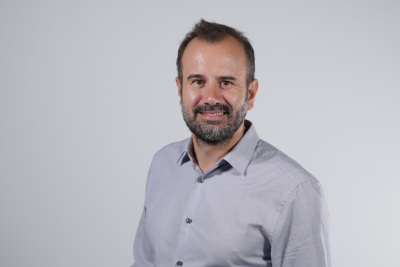
Dr. Matthieu Heller
Maître Einsegnement et Recherche
+41 22 379 62 53
E-mail
Matthieu made his Ph.D. at the laboratoire de L’accélérateur linéaire in Orsay on the measurement of the proton-proton total cross section and absolute luminosity with the ATLAS/ALFA detector. He continued this activity as a Marie Curie Fellow at CERN where he also worked on detector development for medical imaging (AX-PET) in the Detector and Technology group.
He joined the CTAO group at the university in 2014 and acted as the coordinator for the Cherenkov camera realisation. He is now managing the CTAO activities within the group and act as a deputy System Engineer for the large size telescope of CTAO. Matthieu is the leader of the Advanced SiPM camera WG in the Large Size Telescope project of CTAO.
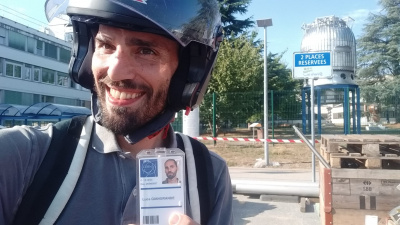
Luca Giangrande
Electronic Engineer
+41 22 379 63 51
E-mail
Luca joined the group in June 2022 as electronic engineer in the FLARE project to build Advanced Cameras for Large Size gamma-ray Telescopes. In particular his task is to design and to realize an ASIC for preamplify and shape the signal of large size SiPMs.
☆ POSTDOCS & MAÎTRE ASSISTANTS
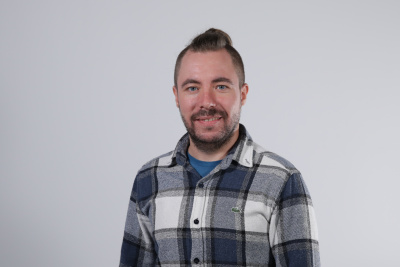
Dr. Mykhailo Dalchenko
PostDoc
+41 22 379 61 37
E-mail
Mykhailo completed his Ph.D. at Ecole Polytechnique, France, focusing on the Higgs boson discovery and on the measurements of the Higgs boson mass and width in the four-lepton final state within the CMS experiment at the LHC. Following his Ph.D., he worked as a postdoc at Texas A&M University, USA, focusing on the development of the data acquisition system for the Gas Electron Multiplier muon detectors for the CMS upgrade.
Joining the DPNC Multi-Messenger High-Energy Astrophysics group in 2020, he now leads calibration and data quality monitoring software development within the CTAO Data Processing and Preservation System and contributes to the LST-1 data analysis.
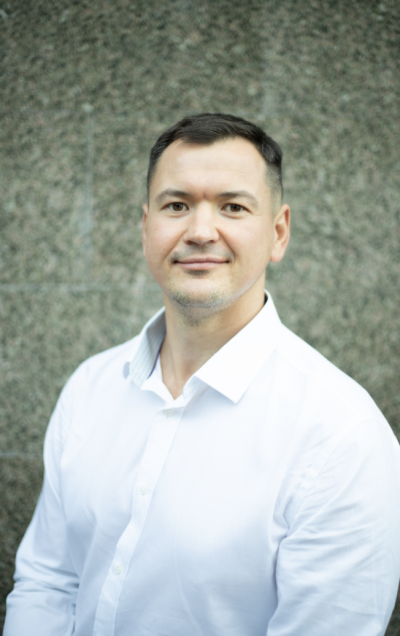
Dr. Leonid Burmistrov
PostDoc
+41 22 379 63 57
E-mail
Leonid made his Ph.D. at the laboratoire de L’accélérateur linéaire in Orsay within SuperB project. His main contribution was the development of the Forward time of flight Cherenkov detector for particle identification. He continues his scientific career in UA9 collaboration at CERN as ingénieur de recherche staff at CNRS, where he developed an in-vacuum Cherenkov detector for proton flux measurements installed in SPS accelerator. Later he joined BELLE2 experiment within ARICH team working on detector simulation, performance estimation, and upgrade.
At the end of 2021, he has joined our UNIGE team. His current work is dedicated to Terzina project where his main contribution is the simulation of the Telescope. He works on the Advanced Camera of LST telescopes of CTAO.
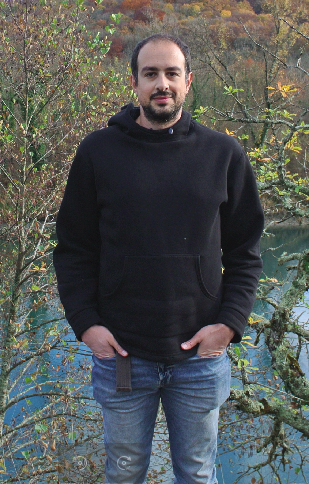
Dr. Georgios Voutsinas
PostDoc
+41 22 379 61 57
E-mail
Georgios studied applied maths in National Technical University of Athens. He made his Ph.D. in picsel group of IPHC Strasbourg, where he worked on applications of monolithic active pixel sensors in physics experiments. He participated in the preparation of future HEP experiments, ILC and FCC, involved mostly in the design and optimisation of the machine detector interface and in pattern recognition algorithms. Currently he is working for the preparation of another future experiment, this time in Astrophysics, the CTAO. His main focus is on the calibration pipeline.
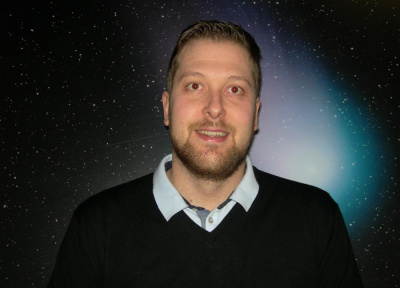
Dr. Matteo Balbo
PostDoc
+41 22 379 62 58
E-mail
Matteo completed his Master studies at the University of Padua in 2009, after a fellowship at the University of Stanford at the Stanford Linear Accelerator Center (SLAC), studying the gamma-ray emission of the Crab pulsar and nebula with the Fermi-LAT satellite. He then moved to Geneva for his Ph.D., at the Astronomy Department, continuing the gamma-ray studies on Galactic sources, publishing the first ever article about the asthonishing Crab's flare in the sub-GeV, signature of the most energetic (PeV) electrons in our Galaxy. He also worked on colliding wind binaries, and in particular on EtaCarinae. He continued his work as a PostDoc in the group of Prof. R. Walter until 2023, working with various collaborations (CTAO, FACT, SST-1M, eAstrogam, ASTRI), performing data analyses from various ground-based and onboard-satellite experiments, remote operational night-shifts for Cherenkov Telescopes, and working recently on the Human Machine Interface for controlling and operating such telescopes.
In november 2023 he moved to the Physics Department joining the UNIGE-CTA group of Prof. T. Montaruli, where he is collaborating with the DPPS, contributing to CalibPipe and in particular taking some responsabilities and developing the data quality pipeline (QualPipe). He also joined the LST1 collaboration, contributing in the data analysis, and helping on the SST-1M eGUI development
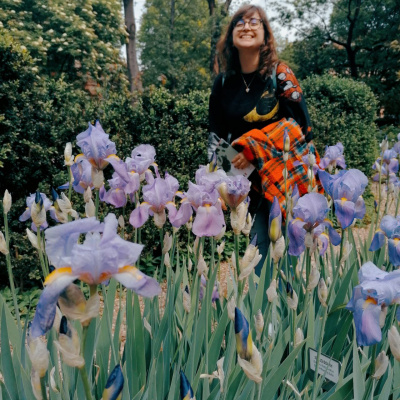
Dr. Caterina Trimarelli
PostDoc
+41 22 379 63 57
E-mail
Caterina started to work on ultra-high-energy cosmic rays during her master's degree in 2019. Her master thesis concerned the possibility of constraining the Lorentz Invariance Violation effects by using the most relevant air shower observables measured at the ground by the Pierre Auger Observatory. She did her Ph.D. at the University of L'Aquila and INFN-LNGS within the Pierre Auger Collaboration. During the Ph.D. she joined mostly the collaboration tasks devoted to the mass composition and shower development studies and she participated to several detector shifts of the experiment. Because of her Lorentz Invariance Violation studies, she is actually a member of the COST Action CA18108.
In February 2023, she joined the CTAO-UNIGE group as a postdoc to work on the TERZINA project on board the NUSES satellite.
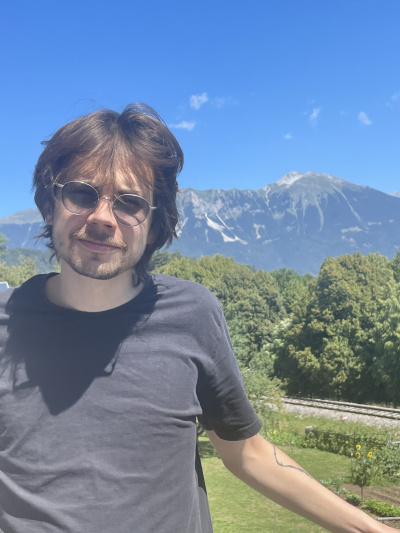
Dr. Vadym Voitsekhovskyi
PostDoc
+41 22 379 61 57
E-mail
Vadym finished his Ph.D. at Taras Shevchenko National University of Kyiv in 2023. While doing his research he spent 1 year as an invited Ph.D. student at the University of Tuebingen. During his Ph.D. thesis, Vadym was searching for ultra-high-energy cosmic-ray sources, modelling gamma-ray emission, and probing the physics of magnetars and galaxy clusters. His main experience lies in programming in Python / C++, data analysis in the field of high-energy gamma-ray astrophysics, computer simulations, theoretical estimations, and calculations on cosmic ray propagation.
Immediately after obtaining a Doctoral degree Vadym joined the CTA group of Geneva University for his 1st PostDoc position in May 2023. He is working on the development of a Calibration Pipeline for Data Processing and Preservation System in the CTAO project. Vadym is also researching telescope calibration methods, and performing data analysis and simulations for LST.
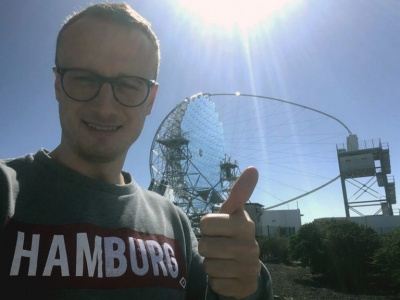
Dr. Tjark Miener
PostDoc
+41 22 379 61 57
E-mail
Tjark made his Ph.D. at the Universidad Complutense de Madrid and IPARCOS (Institute of Particle and Cosmos Physics) in 2023. During his Ph.D. thesis, he studied the “dark side” of our universe, where his main project was the combined Dark Matter search in dwarf spheroidal galaxy observations with the major gamma-ray observatories Fermi-LAT, HAWC, H.E.S.S., MAGIC and VERITAS. He was also contributing to the CTAO analysis development, by applying Deep Learning algorithms to IACT data.
Since joining the CTA-UNIGE group as a PostDoc in July 2023, he is working on the development of the Calibration Pipeline for the Data Processing and Preservation System in the CTA project. Besides, Tjark is working on the performance studies of the Advanced Cameras for Large Size gamma-ray Telescopes using Convolutional Neural Networks. Tjark is also involved in another project regarding the development of an Artificial Intelligence (AI)-based trigger system for the next-generation of IACT cameras.
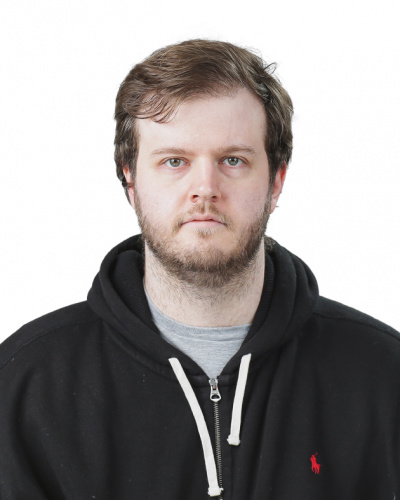
Dr. Christoph Toennis
PostDoc
+41 22 379 63 57
E-mail
Christoph made his Ph.D. at the University of Valencia working on searches for dark matter with the ANTARES neutrino telescope. Following this he started as a PostDoc and later Senior researcher at Sungkyunkwan university working on camera-based calibration systems for the IceCube detector and on dark matter research using IceCube data. He also was a visiting scholar at the University of Utah working on calibration systems for the IceCube detector and the use of alternative energy sources at the south pole. Currently he is contributing to the CTAO data processing and preservation system and the TERZINA detector on board of the NUSES satellite.
☆ PH.D. STUDENTS
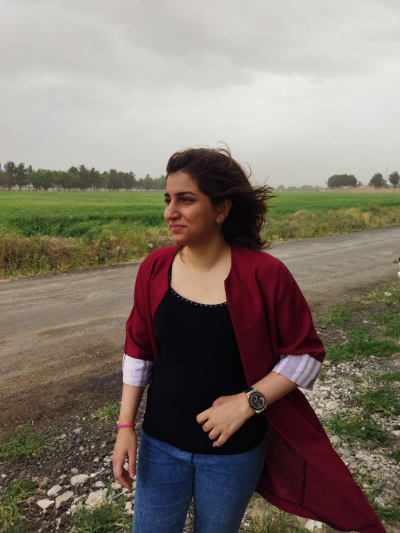
Shideh Davarpanah
Ph.D. student
+41 22 379 63 57
E-mail
Shideh obtained her master in the field of Gravitation and Cosmology at the Shahid Beheshti University in Iran, working on the phenomenological dark energy model and Hubble Tension. Now she is a doctoral student as Swiss Government Excellence Scholarship holders, and she joined the group in September 2023 to work on the NUSES satellite experiment.
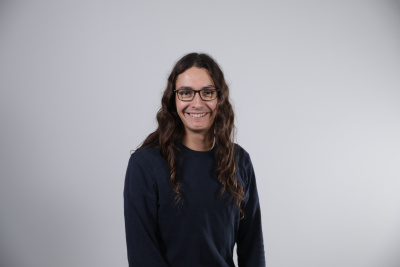
Bastien Lacave
Ph.D. student
+41 22 379 61 57
E-mail
Bastien had his Master at the Observatory of Sauverny, in Astronomy Department of the University of Geneva and joined the group on September 2023. He is now working on the SST-1M telescopes.
☆ MASTER'S STUDENTS
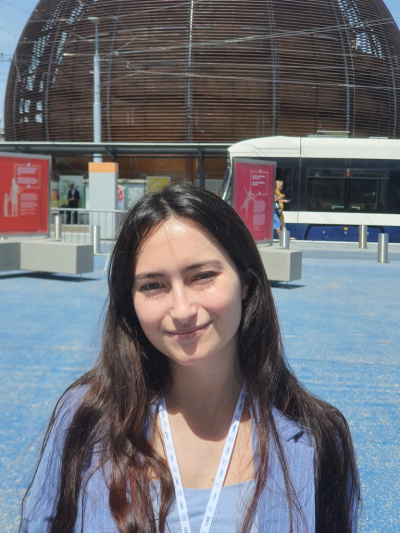
Martina D'Arco
Master student
+41 22 379 63 57
E-mail
Martina obtained her Bachelor in Physics at Sapienza - University of Rome in 2022, after having done a two-semesters Erasmus at the University of Geneva, during which she wrote her bachelor thesis about dark matter and the measurements with the AMS experiment, in collaboration with the AMS group of the University of Geneva. She started the Master in Particle Physics at the University of Geneva in 2023 and now she is working on her Master thesis with the TERZINA group.
☆ PREVIOUS MEMBERS
◦ Antonio Di Pilato (PostDoc in 2023)
◦ Prof. della Volpe was MER in the group from 2014 to 2022. He has now his group with which we collaborate on CTA.
◦ Gabriel Emery (PostDoc 2020-2022)
◦ Andrii Nagai (Maître Assistant, now at SenSL) (2016-2022)
◦ Gregoire Ulrich (PostDoc 2021-2022)
◦ Luca Foffano (PostDoc 2020-2021)
◦ Alessandro Carosi (Maître Assistant 2020-2021)
◦ Lucia Anna Damone (PostDoc 2019-2020)
◦ Yves Renier (Maître assistant)
◦ Victor Coco (Maître assistant)
◦ Anastasia Barbano (PostDoc 2018-2020)
◦ Elisa Prandini (PostDoc)
◦ Enrico Jr Schioppa (PostDoc)
◦ Imen Al Samarai (PostDoc)
◦ Isaac Troyano (Electronic Engineer)
◦ Alessio Porcelli (PostDoc)
☆ PREVIOUS PH.D. STUDENTS
University of Geneva:
◦ Luis David Medina Miranda: Characterization of Photosensitive Devices and Design of an Innovative Large-Sized Gamma-ray Telescope Camera, 22 Dec. 2022
◦ Francesco Lucarelli: Search for Transient Extragalactic Sources of Neutrinos with Ten Years of IceCube Data Contributors, 6 Sep. 2022
◦ Stephanie Bron: Challenges in modern neutrino physics: searches for time-dependent astrophysical neutrino emission with the IceCube detector and study of resonant neutrino-nucleus interactions with a pion and a proton in final state at T2K near detector, 8 Jun. 2022
◦ Cyril Alispach: Maximum Likelihood Estimation: a Method for Calibration, Reconstruction and Data Analysis of Cherenkov Telescopes, 4 Dec. 2020
◦ Steve Njoh Ekoume: Development of a small Cherenkov camera for UHE cosmic rays and CTA data analysis, 10 Nov. 2019
◦ Tessa Carver: Neutrino Point-like source searches with IceCube (earned the Wurth 2 price of the Science Faculty, see this page), 15 Apr. 2019
◦ Asen Christov: Multi-Messenger studies with the IceCube Detector, 11 Oct. 2016.
◦ Rameez Mohammed: IceCube searches for neutrinos from dark matter annihilations in the Sun and cosmic accelerators, 27 Apr. 2016, Laureate of the Chipp Prize 2016.
University of Wisconsin-Madison:
◦ Jon Dumm: Point-source searches with IceCube, 2011.
◦ Mike Baker: Time dependent searches with IceCube, 2011.
☆ PREVIOUS MASTER STUDENTS
◦ Corentin Delacour (Master student, Defended on 26 June 2020, Thesis here at EPFL)
◦ Nicolas De Angelis (Master student, defended on 12 July 2019)

